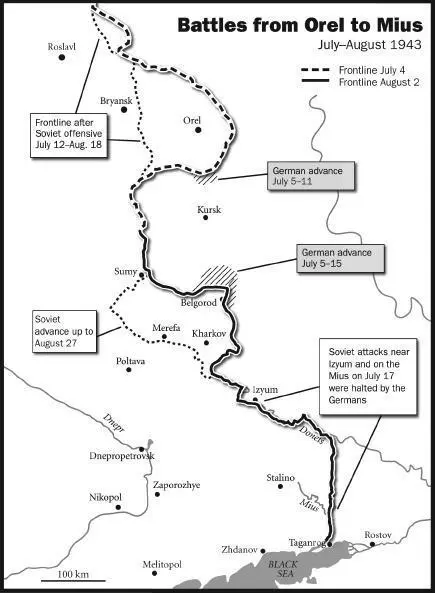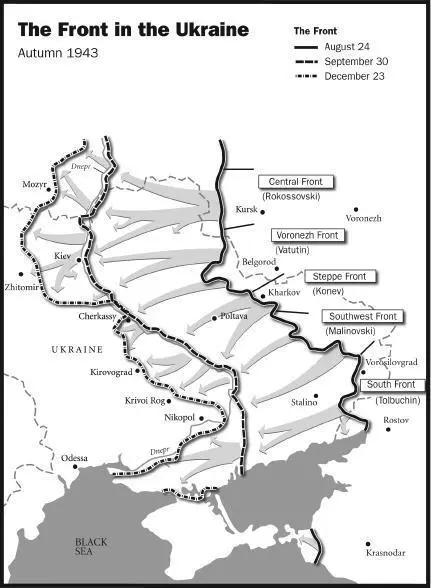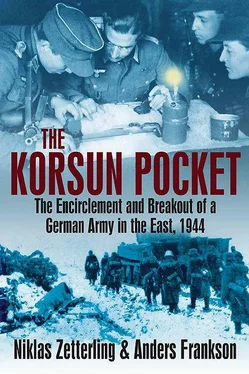The Tide Turns Against Germany
The German efforts to relieve 6th Army failed, and at the beginning of February 1943 the starved remnants of the surrounded 6th Army surrendered. About 100,000 German soldiers went into Soviet captivity. But Stalin was not content with crushing 6th Army. Other offensives were launched, which threatened to crumble the entire German front in the eastern Ukraine. At the same time German forces suffered reverses on other fronts, too. In North Africa, the battle at El Alamein in October 1942 marked the beginning of the end of the Axis forces on the southern shores of the Mediterranean. The Anglo-American invasion of Algeria and Morocco on 8 November 1942 marked the entry of American ground forces into the war against Germany.
The Allied progress continued during the first half of 1943. The Axis forces in North Africa were compressed into a bridgehead in Tunisia, where they finally surrendered in May. On the Atlantic the threat from German submarines was mastered and the Allied build-up of forces in Britain continued remorselessly. On the Eastern Front the Soviet offensives continued. Both the Don and Donets rivers were crossed and the Germans were forced to retreat from the Caucasus. Although a German counteroffensive led by Field Marshal von Manstein gave Hitler one success to boast of before the spring thaw put an end to operations, it was clear that the German situation was much worse than it had been a year ago.
Despite their recent reverses, for the summer of 1943 the Germans prepared an operation to regain the initiative on the Eastern Front, but it was much more limited in scope compared to their previous summer offensives. It was given the code name “Citadel (Zitadelle).” After many postponements, the Germans launched Operation Citadel on 5 July 1943, aiming to cut off the Soviet-held salient around Kursk. The northern prong met with little success, and after a week it stalled. The southern attack force was far more successful, and was only halted by the Red Army at great cost and after substantial reinforcements had been committed. Nevertheless Operation Citadel, which turned out to be the last major German offensive on the Eastern Front, was clearly a failure. 1
Moreover, the Red Army, capitalizing on good intelligence, had not only placed strong defenses where the Germans attacked, it had also built up offensive groupings which were to be committed once the German assault had been contained. The first of these Soviet counteroffensives was directed against the salient around Orel, which was held by the Germans. In fact, the northern prong of Operation Citadel was located in the Orel salient. Three Soviet fronts, West, Bryansk, and Central, were given the task of crushing the German forces in the Orel salient and on 12 July they struck. The Central Front did not achieve much success, as it had been heavily engaged during the German attack. The other two Soviet fronts consisted of fresh forces, however. The West Front in particular made good initial progress, but a prompt German reaction soon followed. The German countermeasures were insufficient to retain the Orel salient, but they did enable the Germans to conduct a fighting withdrawal and exact a heavy toll on the attacking Red Army forces, which made slow progress. Although the Soviet offensive in the Orel salient produced less decisive results than anticipated, the fighting in the Kursk–Orel area showed that the war had definitely turned in a direction that was as favorable to the Red Army as it was disadvantageous to the Germans. 2

At the beginning of summer 1943 it was not apparent to all observers that the Germans were fighting a losing battle, although with hindsight it is clear that the war had turned against them. When Operation Citadel stopped, and the Soviet Orel offensive launched, it became clear that the Red Army had grasped the initiative and would not relinquish it. At the same time, British and American forces invaded Sicily, and a surrender in Italy soon followed. Furthermore, the intensity of the Allied bombings of German cities mounted, with the firestorm of Hamburg as the most telling example. On all fronts the Germans were forced onto the defensive and nowhere was this more apparent than on the Eastern Front.
The Orel fighting required more time and produced less decisive results than the Soviet high command had anticipated, but there were other offensives planned too. On 17 July, the South Front launched an assault on the (reconstituted) German 6th Army, which defended the Mius River. The Germans were compelled to send the II SS-Panzer Corps to the area, as well as other reinforcements. This enabled them to throw back the Soviet assault, but it weakened their defense in the Belgorod area, which was the target for the next Soviet blow.
According to the original Soviet plans, the German assault forces would be counterattacked once Operation Citadel had been halted. However, due to the substantial losses suffered when defending against the German attack, these plans had to be altered. The Germans were allowed to return to their jump-off positions, while the Soviet fronts prepared the next blow.
When the Red Army struck on 3 August, using the Voronezh and Steppe fronts, it made relatively good progress. The Germans were prompted to bring the Grossdeutschland, Das Reich, and Totenkopf divisions to the Kharkov–Belgorod area. They managed to seal off the most threatening Soviet penetrations, but could not prevent the Red Army from recapturing Kharkov, which was accomplished on 23 August. However, again the cost for the Red Army had been considerable. 3
These operations set the pattern for the rest of 1943. The Red Army struck a blow at a chosen sector of the front, which forced the Germans to shift mechanized formations to the threatened sector. Simultaneously the Soviet high command built up forces to attack another part of the front, an attack which was unleashed once German units were engaged by the previous offensive. In this way blow after blow was struck by the Red Army against the front in the east, while the Germans shifted units back and forth. The Germans were always one step behind, and even though they eventually succeeded in containing every Soviet attack, they were gradually pushed back along most of the front.
There were two major disadvantages to the Soviet operational methods employed during the second half of 1943. The Germans never suffered a serious defeat, while the casualties incurred by the Red Army were very high. Between 1 July and 30 September 1943 the Red Army suffered appallingly, enduring almost three million casualties. 4This can be compared to German casualties which amounted to more than 530,000 in the same period. 5In addition, almost 180,000 Germans were evacuated due to disease or left the Eastern Front for other reasons. 6
Replacements were wholly insufficient to cover the German losses, as less than 280,000 men arrived either as replacements or returning convalescents. 7Furthermore, the low German replacement rate was dwarfed by the influx of replacements to the Red Army, which must have received more than two million men as replacements, returning convalescents, and reinforcements. Had the Red Army not enjoyed this massive advantage it seems highly unlikely that it could have continued its offensives. 8

Evgeni Bessonov at the Bryansk Front
The enormous casualties suffered by the Red Army during its offensive operations are not only evident in the statistics. The danger was very real to the men who fought in the foxholes too. However, for them many days could pass without experiencing anything particularly harmful, until they suddenly found themselves caught up in extremely costly actions. Evgeni Bessonov spent more than a year in military service, mostly in training, until he was sent to the Bryansk Front in July 1943 to serve as a platoon commander in 4th Tank Army. Transport shortages forced him and the other soldiers he travelled with to hitchhike and walk part of the distance between Moscow and the front. 9
Читать дальше














